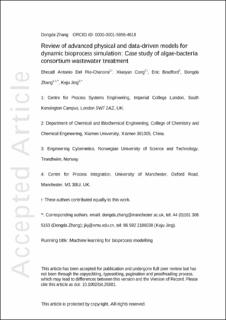| dc.contributor.author | del Rio-Chanona, Ehecatl Antonio | |
| dc.contributor.author | Cong, Xiaoying | |
| dc.contributor.author | Bradford, Eric | |
| dc.contributor.author | Zhang, Dongda | |
| dc.contributor.author | Jing, Keju | |
| dc.date.accessioned | 2020-05-15T07:40:35Z | |
| dc.date.available | 2020-05-15T07:40:35Z | |
| dc.date.created | 2019-05-21T14:06:25Z | |
| dc.date.issued | 2019 | |
| dc.identifier.citation | Biotechnology and Bioengineering. 2019, 116 (2), 342-353. | en_US |
| dc.identifier.issn | 0006-3592 | |
| dc.identifier.uri | https://hdl.handle.net/11250/2654555 | |
| dc.description.abstract | Microorganism production and remediation processes are of critical importance to the next generation of sustainable industries. Undertaking mathematical treatment of dynamic biosystems operating at any spatial or temporal scale is essential to guarantee their performance and safety. However, constructing physical models remains a challenge due to the extreme complexity of process biological mechanisms. Data‐driven models also encounter severe limitations because datasets from large‐scale bioprocesses are often scarce without complete information and on a restricted operational space. To fill this gap, the current research compares the performance of advanced physical and data‐driven models for dynamic bioprocess simulations subject to incomplete and scarce datasets, which to the best of our knowledge has never been addressed before. In specific, kinetic models were constructed by integrating different classic models, and state‐of‐the‐art hyperparameter selection frameworks were developed to design artificial neural networks and Gaussian process regression models. An algae–bacteria consortium wastewater treatment process was selected to test the accuracy of these modeling strategies, as it is one of the most sophisticated biosystems due to the intricate mutualistic and competitive interactions. Based on the current results and available data, a heuristic model selection procedure is provided. This study paves the way to facilitate future bioprocess modeling. | en_US |
| dc.language.iso | eng | en_US |
| dc.publisher | Wiley | en_US |
| dc.title | Review of advanced physical and data‐driven models for dynamic bioprocess simulation: Case study of algae–bacteria consortium wastewater treatment | en_US |
| dc.type | Peer reviewed | en_US |
| dc.type | Journal article | en_US |
| dc.description.version | acceptedVersion | en_US |
| dc.source.pagenumber | 342-353 | en_US |
| dc.source.volume | 116 | en_US |
| dc.source.journal | Biotechnology and Bioengineering | en_US |
| dc.source.issue | 2 | en_US |
| dc.identifier.doi | 10.1002/bit.26881 | |
| dc.identifier.cristin | 1699180 | |
| dc.description.localcode | This is the peer reviewed version of an article, which has been published in final form at [https://doi.org/10.1002/bit.26881]. This article may be used for non-commercial purposes in accordance with Wiley Terms and Conditions for Self-Archiving. " | en_US |
| cristin.ispublished | true | |
| cristin.fulltext | postprint | |
| cristin.qualitycode | 1 | |
